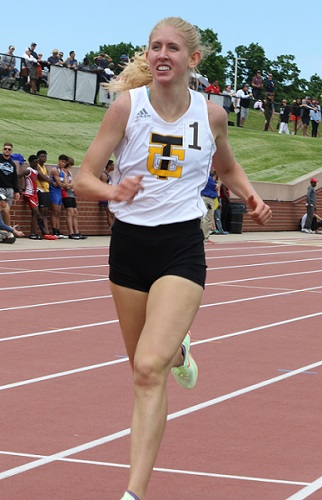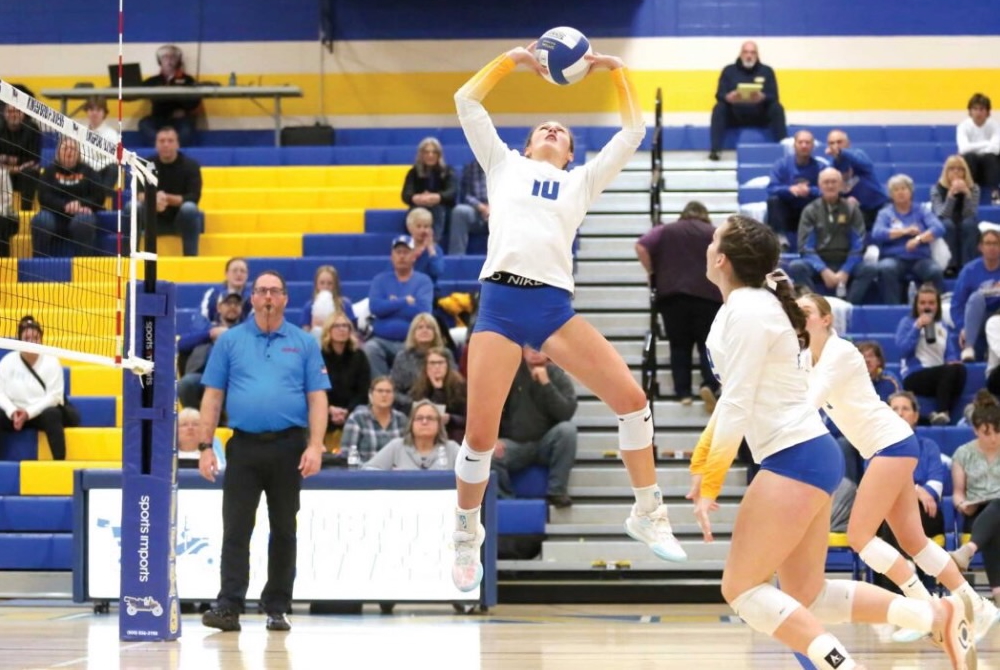
Renaissance Follows Record-Setting Jackson to 1st Division 1 Finals Win
By
Paul Costanzo
Special for MHSAA.com
June 4, 2022
ROCKFORD – Before she even ran a race Saturday, Kaila Jackson had already established herself as one of the best sprinters in MHSAA history.
But in her final meet, she gave everyone at the Lower Peninsula Division 1 Track & Field Finals one final show.
The Detroit Renaissance senior won four Finals titles Saturday, repeating the feat she had accomplished in 2021, and led the Phoenix to their first Division 1 team title.
“The question was asked early in the season if I thought Kaila was one of the all-time great sprinters,” Renaissance co-coach Calvin Johnson said. “She solidified her legacy today. She solidified her legacy. With her going down to Georgia now to be a Bulldog, there’s nothing I can say but they’re getting a great athlete – a great student-athlete. It’s unfortunate they don’t have an MVP trophy, because she should get it, hands down.”
Jackson was responsible for 40 of Renaissance’s 80 points on the day. Three-time reigning champion Oak Park was second with 60. Ann Arbor Huron (55), Holland West Ottawa (47) and Ann Arbor Pioneer (38) rounded out the top five.
It was the first Finals title for Renaissance since 2007, when it finished a run of 10 Division 2/Class B titles over 11 seasons. The Phoenix were runners-up to Oak Park both of the past two seasons.
“It’s well overdue,” Renaissance co-coach Darnell Hall said. “It’s a good honor to finally get that monkey off our back. Especially with a good group of girls, the elite kids we have, this was the last thing they needed to solidify their legacy in the state of Michigan, was that Michigan state title.”
Jackson won the 100 meters and 200 meters and was part of the winning 400 and 800 relay teams. Olivia Jenkins, Madison Sheard and Jayla Graham joined Jackson on the 400 relay, while Jenkins, Chloe Vines and Jayla Dace joined her on the 800 relay.
Jackson’s winning 200-meter time of 23.51 seconds broke the all-Finals record of 23.74 run by Shayla Mahan of Detroit Mumford in 2006.
 “It feels amazing to break a state record,” Jackson said. “I knew it was going to come, but I’m happy it came now. I worked very hard for this. I just feel so accomplished.”
“It feels amazing to break a state record,” Jackson said. “I knew it was going to come, but I’m happy it came now. I worked very hard for this. I just feel so accomplished.”
She won the 100 in 11.64, and the relays came in at 47.01 and 1:38.09, respectively.
“I really work hard for this,” Jackson said. “Everything paid off, all the hard practices, the crying, smiling, it’s paid off. I’ve worked very hard.”
The Phoenix also got a Finals title from Leeah Burr, who won the 400 in 55.05.
Oak Park had three champions on the day, led by Morgan Roundtree’s record-breaking performance in the 300 hurdles. Roundtree’s time of 42.38 broke the LP Division 1 Finals record of 42.64 set by Wyandotte Roosevelt’s Kyana Evans in 2017. Ann Arbor Huron’s Mya Georgiadis was second in the race at 42.52, also breaking the record.
Nonah Waldron won the 100 hurdles for Oak Park in 13.9 seconds, while Drelin Mapp won the long jump with a distance of 18 feet, 2.25 inches.
Two others joined Jackson in winning multiple individual titles on the day.
Allen Park’s Abigail Russell won the discus and the shot put. Her throw of 144-4 in the discus won by nearly seven feet, while her throw of 41-8.25 in the shot put won by eight inches.
Traverse City Central’s Julia Flynn pulled off the 1,600/800 double, and even came back and placed fifth in the 3,200.
She won the 1,600 in 4:39.75, and the 800 in 2:08. In the 800, she took control of the race about 250 meters in, and never relinquished her lead.
“I wanted to go out in my first lap, not crazy, crazy, crazy fast,” Flynn said. “I let myself ease into the competition a little bit, had girls in front of me. Then, I had the fear of getting boxed in, so then I just peaced out. I was trying to use my competition, I wanted to stay with them a little longer than I did, but I started to get in that inner lane, and I was like, ‘I don’t want to misstep and get DQ’d.”
Dexter’s Sophia Mettes repeated as champion in the pole vault, clearing 13 feet to hold off a tough field.
“Coming into this I was a little nervous, because I knew I had really good competition,” Mettes said. “Natalie Blake (Holland West Ottawa), I’m competing with her next year (at Michigan State), so I’m super excited. She’s been looking so strong. Brooke Bowers (Grand Rapids Forest Hills Central), she’s been looking great, too. I knew I had a lot to look up to, and I was feeling a little tired coming in, but it was a great competition. I just got nervous throughout the whole thing, but my adrenaline kept me going.”
Holland West Ottawa’s Arianne Olson, who was runner-up to Flynn in the 1,600, won the 3,200 by more than 10 seconds, finishing in 10:23.43.
Ann Arbor Pioneer won the 3,200 relay in 8:55.58 with the team of Sylvia Sanok Dufallo, Emily Cooper, Cookie Baugh and Sarah Forsyth.
Ann Arbor Huron won the 1,600 relay in 3:52.81 with the team of Mackenzie Robinson, Jada Wilson, Christabelle Obi and Georgiadis.
Pioneer’s Gabriella Newman won the high jump with a jump of 5-8.
PHOTOS (Top) Detroit Renaissance's Kaila Jackson, front, powers to a win during Saturday's Lower Peninsula Division 1 Finals. (Middle) Traverse City Central's Julia Flynn turns into the straightaway during one of her races. (Click for more from John Brabbs/Run Michigan.)

Kingsford's Kreider Prepared for Next Level After Finishing Stellar Flivvers Career
By
John Vrancic
Special for MHSAA.com
June 19, 2025
KINGSFORD — After completing a successful high school volleyball career, Maddy Kreider is ready to take the next step.
 The Kingsford senior is taking her talents to Michigan Tech, where she’s expected to continue primarily as a setter.
The Kingsford senior is taking her talents to Michigan Tech, where she’s expected to continue primarily as a setter.
“That will be a big step for sure, but it’ll be exciting being with the girls,” she said. “The girls are taller in college. It will definitely be an adjustment, physically and mentally. We’ll be traveling longer distances, and it’ll be a matter of improving the mental part of my game.”
Kreider was selected the Upper Peninsula’s Defensive Player of the Year her final two seasons after the U.P. Sportswriters and Sportscasters Association began voting for all-U.P. volleyball.
“That’s quite an accomplishment,” she said. “It’s a real honor playing with girls I grew up with. We had a great season.”
The 5-foot-8 setter was a four-year starter and two-year team captain at Kingsford, leading the Flivvers to three Division 2 District titles and back-to-back undefeated Great Northern Conference championships. She twice was named GNC Player of the Year.
She was also selected all-state first team in the fall and all-state second team in 2023, and all-region throughout her prep career. Her serving percentage also topped .900 throughout her four seasons on varsity.
 Last fall, the Flivvers reached the Regional Semifinal at Manistique where they dropped a 3-2 decision to Kingsley.
Last fall, the Flivvers reached the Regional Semifinal at Manistique where they dropped a 3-2 decision to Kingsley.
“I thought we’d get through,” Kreider said. “We came out lights out in the first two sets, then it was close in the last three.”
Also among the team’s highlights this past fall was a victory at Calumet, approximately 2½ weeks after dropping a 3-1 decision to the Copper Kings on Kingsford’s home floor.
“We wanted to play them,” Kreider said. “They’re a great bunch of girls to play against. They’ve been the measuring stick up here for many years. Winning on their floor was super exciting. We knew we had to play well just to be competitive. That was a great confidence builder for our group. We were definitely on a high going into the District.”
The Flivvers opened their postseason with a 3-1 triumph over Houghton, then defeated Escanaba in straight sets in the District Final.
Kreider will join Calumet senior Maddie Torola at MTU this fall. Torola, who recorded a season-high 19 kills in the four-set victory at Kingsford, helped the Copper Kings finish 29-5 and reach the Division 3 Regional Final at Sault Ste. Marie where they dropped a 3-2 decision to Traverse City St. Francis.
“It was fun playing against her in high school,” Kreider said. “It will be even more fun playing as teammates. It’ll be exciting to be playing on the same team.”
Both will be playing under new head coach Cindy Pindral at Tech. Both of Kreider’s parents played for the Huskies, her mother (and Kingsford varsity coach) Jaclynn volleyball from 1998-2002 and her father Jason basketball from 1997-2000.
Maddy Kreider recently earned an additional honor when she was selected Female Athlete of the Year for Kingsford’s Class of 2025. She recently completed a solid track & field season for the Flivvers.
At the U.P. Division 1 Finals, Kreider placed fourth in the 100-meter dash (13.2) and anchored the Flivvers to a third-place finish in the 800 relay (1:51.57) and fourth in the 400 (53.03) on their home track.
Kreider was named one of 32 MHSAA/Farm Bureau Insurance Scholar-Athlete Award winners this winter and plans to study exercise science and kinesiology at MTU.
 John Vrancic has covered high school sports in the Upper Peninsula since joining the Escanaba Daily Press staff in 1985. He is known most prominently across the peninsula for his extensive coverage of cross country and track & field that frequently appears in newspapers from the Wisconsin border to Lake Huron. He received the James Trethewey Award for Distinguished Service in 2015 from the Upper Peninsula Sportswriters and Sportscasters Association.
John Vrancic has covered high school sports in the Upper Peninsula since joining the Escanaba Daily Press staff in 1985. He is known most prominently across the peninsula for his extensive coverage of cross country and track & field that frequently appears in newspapers from the Wisconsin border to Lake Huron. He received the James Trethewey Award for Distinguished Service in 2015 from the Upper Peninsula Sportswriters and Sportscasters Association.
PHOTOS (Top) Kingsford’s Maddy Kreider sets for her teammates during a match last season. (Middle) Kreider, right, takes a photo with Kingsford’s Male Athlete of the Year Gavin Grondin. (Photos provided by the Kingsford athletic department.)

